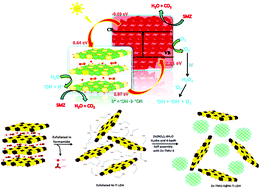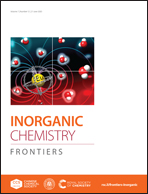An advanced composite with ultrafast photocatalytic performance for the degradation of antibiotics by natural sunlight without oxidizing the source over TMU-5@Ni–Ti LDH: mechanistic insight and toxicity assessment†
Abstract
Pharmaceuticals are considered as emerging organic contaminants that have become a serious environmental problem, which endanger human health and environmental bio-diversity. Several studies have attempted to develop new technologies for the efficient removal of these contaminants from the water cycle. Among these, the photocatalytic degradation of contaminants is considered as a sustainable and economical option. Herein, we have designed and engineered a Zn(II)-based metal–organic framework@Ni–Ti layered double hydroxide (Zn-TMU-5@Ni–Ti LDH) composite as a well-organized photocatalyst to degrade the antibiotic compound sulfamethoxazole (SMZ) via natural solar light irradiation. It was found that the Zn-TMU-5@Ni–Ti LDH composite significantly improved the removal efficiency of SMZ in comparison with bare Ni–Ti LDH. In particular, with 0.1 g L−1 dose of the optimized Zn-TMU-5@30%Ni–Ti LDH material, the photocatalytic efficacy was increased by >98% in 45 minutes. The formation of OH radicals over the Zn-TMU-5@30%Ni–Ti LDH composite has been proved by employing a terephthalic acid probe in photoluminescence (PL) spectroscopy. In addition, the catalytic process is accompanied by effective mineralization of the products to be degraded. The exceptional photocatalytic performance of the composite may be ascribed to the synergistic impact of Ni–Ti LDH and Zn-TMU-5, which results in the increased absorption of solar light, effective segregation of photoinduced charge carriers, and fast charge transfer to the reaction sites/conduction band potential of Ni–Ti LDH and Zn-TMU-5. Moreover, the Zn-TMU-5@Ni–Ti LDH composite exhibited good reusability of up to 5 cycles. Thus, the findings demonstrate that the Zn-TMU-5@Ni–Ti LDH composite is an efficient photocatalyst for large-scale SMZ removal via solar light, which can be further applied for the removal of other types of drugs and new toxic-organic pollutants.



 Please wait while we load your content...
Please wait while we load your content...